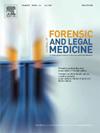Postmortem redistribution of carbofuran and benzofuranol in rats determined using solid phase extraction by HPLC-MS/MS
IF 1.2
4区 医学
Q3 MEDICINE, LEGAL
引用次数: 0
Abstract
Carbofuran has been implicated in many homicide and suicide cases worldwide. We investigated the postmortem redistribution of carbofuran and its main metabolite benzofuranol using the rat model. Carbofuran (50 mg/kg) was intragastric administrated, followed by euthanasia 1 h post injection. Tissues including cardiac blood, lung, liver, kidney, spleen, brain, myocardium, and thigh muscle were collected at different postmortem intervals (0, 12, 24, 48, 72, and 96 h). The samples were extracted using solid phase extraction cartridges filled with self-prepared multi-wall carbon nanotubes based molecular imprinting polymers, and analyzed using validated liquid chromatography tandem mass spectrometry method. The concentrations of carbofuran and benzofuranol were found both influenced by postmortem redistribution and postmortem degradation throughout the postmortem period. The carbofuran concentration increased in cardiac blood, liver and kidney, but decreased in lung, while benzofuranol concentration increased in cardiac blood, liver, spleen, and kidney. The benzofuranol in cardiac blood and liver is more prominent than carbofuran after 80 h after death, which implies that benzofuranol could be regarded as an alternative marker in carbofuran poisoning cases for the corpse died for a long time when carbofuran could hardly be detected. These findings provide a valuable aiding information when determining the cause of death of carbofuran poisoning.
HPLC-MS/MS固相萃取法测定大鼠死后体内呋喃和苯并呋喃醇的再分布
在世界范围内,许多杀人和自杀案件都与呋喃有关。我们利用大鼠模型研究了呋喃及其主要代谢物苯并呋喃醇的死后再分布。Carbofuran (50 mg/kg)灌胃,注射后1 h安乐死。在不同的死后时间间隔(0、12、24、48、72和96 h)收集心脏血液、肺、肝、肾、脾、脑、心肌和大腿肌肉等组织,使用固相萃取盒进行提取,萃取盒中填充了自制的基于多壁碳纳米管的分子印迹聚合物,并使用经过验证的液相色谱串联质谱法进行分析。发现在整个死后期间,呋喃和苯并呋喃醇的浓度都受到死后再分布和死后降解的影响。心脏血、肝、肾中呋喃浓度升高,肺中降低,而心脏血、肝、脾、肾中苯并呋喃醇浓度升高。在死亡后80 h,心脏血液和肝脏中的苯并呋喃比呋喃更突出,这意味着对于长时间无法检测到呋喃的死亡尸体,苯并呋喃可以作为呋喃中毒病例的替代标记物。这些发现为确定呋喃中毒死亡原因提供了有价值的辅助信息。
本文章由计算机程序翻译,如有差异,请以英文原文为准。
求助全文
约1分钟内获得全文
求助全文
来源期刊

Journal of forensic and legal medicine
MEDICINE, LEGAL-
CiteScore
2.70
自引率
6.70%
发文量
106
审稿时长
57 days
期刊介绍:
The Journal of Forensic and Legal Medicine publishes topical articles on aspects of forensic and legal medicine. Specifically the Journal supports research that explores the medical principles of care and forensic assessment of individuals, whether adult or child, in contact with the judicial system. It is a fully peer-review hybrid journal with a broad international perspective.
The Journal accepts submissions of original research, review articles, and pertinent case studies, editorials, and commentaries in relevant areas of Forensic and Legal Medicine, Context of Practice, and Education and Training.
The Journal adheres to strict publication ethical guidelines, and actively supports a culture of inclusive and representative publication.
 求助内容:
求助内容: 应助结果提醒方式:
应助结果提醒方式:


